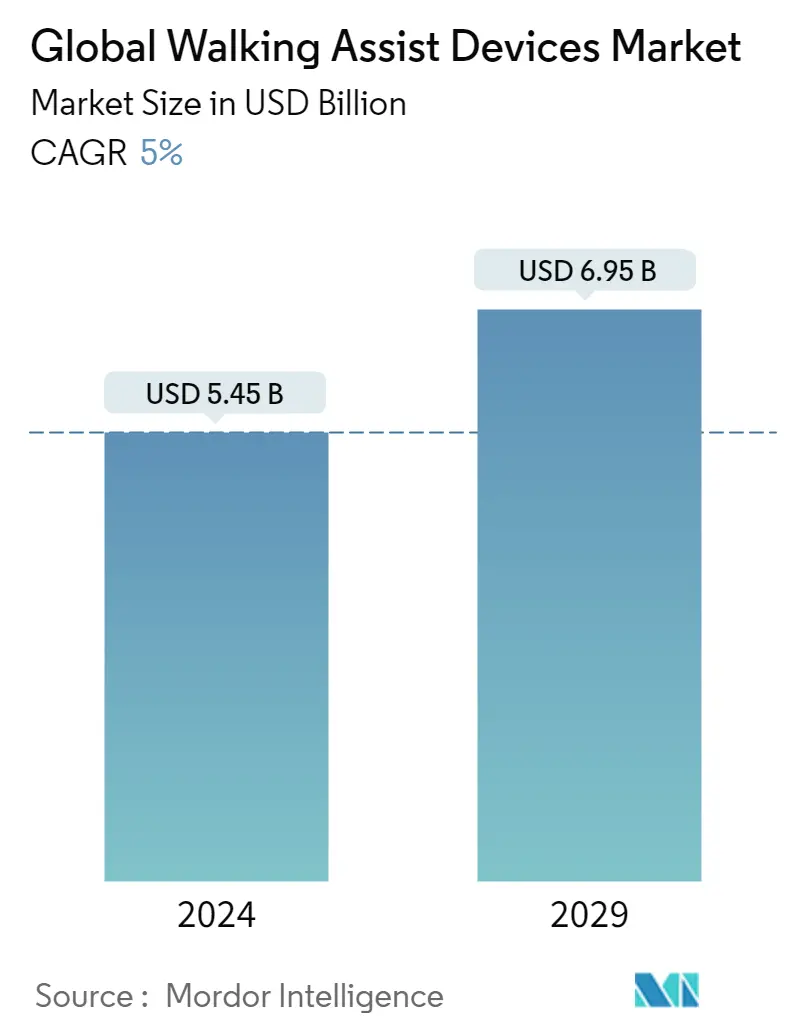Market Size of Global Walking Assist Devices Industry

| Study Period | 2019 - 2029 |
| Market Size (2024) | USD 5.45 Billion |
| Market Size (2029) | USD 6.95 Billion |
| CAGR (2024 - 2029) | 5.00 % |
| Fastest Growing Market | Asia Pacific |
| Largest Market | North America |
Major Players
*Disclaimer: Major Players sorted in no particular order |
Need a report that reflects how COVID-19 has impacted this market and its growth?
Walking Assist Devices Market Analysis
The Global Walking Assist Devices Market size is estimated at USD 5.45 billion in 2024, and is expected to reach USD 6.95 billion by 2029, growing at a CAGR of 5% during the forecast period (2024-2029).
Covid-19 has significantly impacted the walking assist devices market due to the supply chain pressures faced across the globe. For instance, according to the news published titled 'Equipment amnesty called in response to supply chain pressures' in August 2021, pressures on the supply chain are causing a scarcity of essential items including hoists, hospital beds, mobility, and toileting aids. This might have impacted the market growth due to the dramatic decline in sales of walking assist devices during the pandemic.
The key factors propelling the market are the increasing incidences of rheumatoid and osteoarthritis, the surging demand for rehabilitation equipment, and the steep rise in the aging population.
The rise in the elderly population and rise in the prevalence of musculoskeletal disorders such as osteoarthritis, rheumatoid arthritis, among others has also led to the growth of the walking assist devices market. For instance, in June 2022, according to the World Health Organization (WHO), approximately 1.71 billion people have musculoskeletal conditions worldwide. Such a huge prevalence of musculoskeletal disorders will lead to increased adoption of walking assist devices, driving the market growth.
Furthermore, the increasing prevalence of debilitating neurological diseases, rheumatoid arthritis, and osteoarthritis have been contributing to the increased percentage of the population with a disability to walk. For instance, according to the Global RA Network in 2021, more than 350 million people throughout the world suffer from arthritis, which is a prevalent health issue and a major contributor to disability. This will further lead to higher adoption of walking assist devices driving the market growth.
Moreover, as the geriatric population is growing, the demand for walking assist devices is also rising across the world. Also, the walking assist devices provide balance, support, and ultimately, the subsequent ability to survive independently. The aforementioned factors are responsible for the increasing geriatric population getting attracted to these devices.
In addition, the rise in healthcare expenditure and funding by the government for the development of robots to improve health are also significantly contributing to the market growth across the world. However, high cost of purchase of walking assist devices act as a restriaing factor for the market studied.
